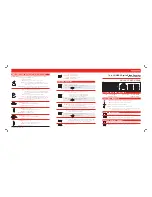
157
motion detection (MD), Alarm, MD & alarm.
In
Figure 4-93, Select icon
of several dates, all checked items can be edited together.
Now the icon is shown as
.
Click
to delete a record type from one period.
In
Figure 4-93. Click button
after one date or a holiday, you can see an interface shown as
in Figure 4-94. There are four record types: regular, motion detection (MD), Alarm, MD & alarm.
Anti-dither: Here you can set anti-dither time. Here you can set anti-dither time. The value ranges
from 5 to 600s. The anti-dither time refers to the alarm signal lasts time. It can be seem as the
alarm signal activation stays such as the buzzer, tour, PTZ activation, snapshot, channel record.
The stay time here does not include the latch time. During the alarm process, the alarm signal can
begin an anti-dither time if system detects the local alarm again. The screen prompt, alarm upload,
email and etc will not be activated. For example, if you set the anti-dither time as 10 second, you
can see the each activation may last 10s if the local alarm is activated. During the process, if
system detects another local alarm signal at the fifth second, the b uzzer, tour, PTZ
activation,
snapshot, record channel will begin another 10s while the screen prompt, alarm upload, email will
not be activated again. After 10s, if system detects another alarm signal, it can generate an alarm
since the anti-dither time is out.
Show message: System can pop up a message to alarm you in the local host screen if you enabled
this function.
Alarm upload: System can upload the alarm signal to the network (including alarm
centre) if you enabled current function.
Send email: System can send out email to alert you when alarm occurs.
Record channel: you can select proper channel to record alarm video (Multiple choices). At the
same time you need to set alarm record in schedule interface (Main Menu->Setting->Schedule) and
select schedule record in manual record interface (Main Menu->Advance->Manual Record).
Latch: Here is for you to set proper delay duration. Value ranges from 10 to 300 seconds. System
automatically delays specified seconds in turning off alarm and activated output after external alarm
cancelled.
Tour: Here you can enable tour function when alarm occurs. S ystem supports 1/8-window tour.
Please note the tour setup here has higher priority than the tour setup you set in the Display
interface. Once there two tours are both enabled, system can enable the alarm tour as you set here
when an alarm occurred. If there is no alarm, system implements the tour setup in the Display
interface.
Snapshot: System can snapshot corresponding channel when an alarm occurs. Please note the
activation snapshot has the higher priority than schedule snapshot. If you have enabled these two
types at the same time, system can activate the activation snapshot when alarm occurs, and
otherwise system just operates the schedule snapshot.
Buzzer: Highlight the icon to enable this function. The buzzer beeps when alarm occurs.
Please note, network alarm means the alarm signal from the TCP/IP. You can use NET SDK to
activate network alarm. Comparing with the local alarm, there is no type, anti-dither, alarm
upload function.
Please highlight icon
to select the corresponding function. After setting all the setups please
click save button, system goes back to the previous menu.
Summary of Contents for ELI-ECOM-4
Page 7: ...vii APPENDIX E COMPATIBLE SWITCHER LIST 265 APPENDIX F COMPATIBLE WIRELESS MOUSE LIST 266 ...
Page 15: ...71 2 3 ConnectionSample ELI ECOM 4 ELI ECOM 8 ELI ECOM 16 ...
Page 85: ...153 Figure 4 81 Figure 4 82 Figure 4 83 ...
Page 90: ...158 Figure 4 88 Figure 4 89 ...
Page 91: ...159 Figure 4 90 Figure 4 91 ...
Page 92: ...160 Figure 4 92 Figure 4 93 Figure 4 94 ...
Page 152: ...220 Figure 5 51 Figure 5 52 Figure 5 53 ...
Page 194: ...262 Maxtor DiamondMax 20 STM3320820AS 320G SATA Maxtor DiamondMax 20 STM3250820AS 250G SATA ...
















































